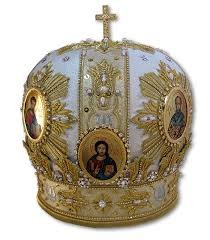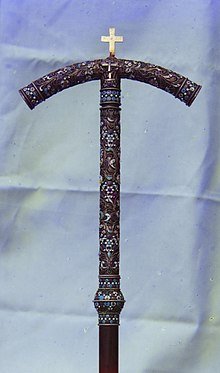Why Does the Bishop Get ‘Dressed’ In Church?
Many of us grew up with the practice on parish feast days, when the bishop was visiting, the parish priest and children would meet the bishop with flowers, bread, salt etc., which was then followed by his vesting in the centre (in front of the tetrapod). But did you know, however, that this practice is unique to the Slavic churches (and therefore in the Greek Catholic/Uniates as well)? In the Greek and Antiochian jurisdictions, the vesting actually occurs in the altar.
But Still, Why do We do it?
In the book “The Divine Liturgy: A Commentary In the Light of the Fathers” the author, Hieromonk Gregorios, explains:
“In early Byzantine times, when the Divine Liturgy began with what is now “The Little Entrance” [when the choir sings “прийдіть поклонімось”], the first liturgical act was the entry of the bishop into the church. The bishop would then put on his episcopal vestments in the middle of the church, as is often done today. The vesting of the bishop represents the Incarnation of the Word. As ‘Word of God, being without flesh, clothed Himself in holy flesh from the Holy Virgin, so the bishop clothes himself in his sacred vestments which signify the Incarnation of Christ, and the marks of His Incarnation.’ (St. Hippolytus of Rome) The bishop is the envoy of the Lord, whom Christ, the Master of the household, sends out to administer His affairs. He comes into the house of God to perform Christ’s work: to bring back the lost sheep into the one flock of the Church. The “omophorion,” the vestment distinctive to the bishop, symbolizes the salvation and recall of the sheep that had strayed … This liturgical practice reveals to us that the bishop is the living image of Christ our Master [an icon]… and the faithful gathered in the church are the Israel of grace which receives the Messiah.”
What About All Those Layers?
As excerpted from St. Sophia Ukrainian website.Standing on the ambo, the deacon prays aloud the prayers of vesting while the priest incenses. There is a wonderful contrast in the theology of vesting. There are actually two sets of vesting prayers: those said quietly by the bishop and those proclaimed aloud by the protodeacon. These together illustrate the salvific dynamic of passion and resurrection. The protodeacon proclaims the victory of the Resurrected Christ, for the bishop’s vesting is a ritualization of each Christian’s “putting on Christ.” The prayers said by the bishop are taken from the passion narratives and ritualize that other aspect of our baptism, that we are baptized into the death of Christ.
Stykhar
The Bishop is vested with the stikhar/sticharion. This is the white garment of the saints given to every Christian at baptism to symbolize that he has “put on Christ.” As Revelations 3:5 tells us, “…those who prove victorious will be dressed…in white robes; I shall not blot their names out out of the Book of Life, but acknowledge their names in the presence of my Father and His Angels” And Revelations 7:14-15 reminds us, “…they have washed their robes white again in the Blood of the Lamb, they now stand in front of God’s throne and serve Him day and night in His Sanctuary.” As this is the basic garment of every Christian, the same garment (though variously decorated) is worn by those newly baptized, called neophytes, and all ranks of clergy. In contrast, the bishop prays, “Herod and his soldiers treated Him contemptuously and mocked Him, and after clothing Him in resplendent garb, sent Him back to Pilate (Luke 23:11).”
Epitrakhyl (epitrachelion)
The bishop is vested with the epitrakhil (a stole), a piece of cloth that hangs down from his neck to his feet. This stole symbolizes God’s grace poured out to ordain him to the priesthood.
Poyas (zone)
The Bishop is vested with the Poyas (Belt) representing the Strength of God and Protection from on High (Psalm 17:32-33). “Pass the belt around their waists and put the mitres on their head. And by irrevocable ordinance the priesthood will be theirs. This is how you are to vest Aaron and his sons” (Exodus 29:8-9) The Protodeacon proclaims, “Blessed be God who girds you with strength and makes your way blameless…” The Bishop prays, “…They bound Him, lead Him away, and handed him over to Pilate the governor. (Matt. 27:1-2).”
Cuffs (epimanikia)
The bishop is vested with the cuffs, ritualizing the hands of God in creation and in fashioning humanity and redeeming it, giving it wisdom to fulfill the commandments (Exodus 15:6-7; Psalm 117:15-17, Psalm 118:73). While the protodeacon proclaims, “Your right hand, O Lord, was made glorious in power…”, the bishop recalls that these same cuffs are also reminiscent of the shackles with which the Lord was bound and scourged.
Sakkos (phelonion)
The bishop is vested with the sakkos/saccos: a wide sleeved garment fastened by bells which is reminiscent of the seamless garment of Christ, whose priesthood the bishop is a successor of through the Apostles (Matt. 27:27-29). The garment takes its theological origins from the garments of the priests of Israel, specifically the ephod (Exodus 28:31-35). The protodeacon prays, “Your High Priests, O Lord, shall be clothed with justice, and Your saints shall exult with joy… (Psalm 131/132:9).” The Bishop prays, “…the soldiers of the governor took Jesus…they stripped off his clothes and threw a scarlet military cloak about Him, weaving a crown of thorns, they place it on His Head and a reed in His Hand…”
Epigonation
The bishop is vested with the epigonation: a square cloth hung on his right side, symbolizing the “sword of the Spirit, which is the Word of God” (Eph. 6:17). Its history is uncertain with some believing it originated with a thigh shield common in the Byzantine empire to protect the leg from a sword hitting it while others belief it was a bag in which the wearer’s documents of authority were kept. The epigonation symbolizes that the Bishop is bestowed with the authority to go forth and, guided by God’s own Hand, uphold the cause of truth, humility and justice.
Omophor (omophorion)
The bishop is vested with the omophor, a wide cloth that is draped over the shoulders and hangs down both front and back. It is symbolic of the Christ the Good Shepherd who goes in search of the lost sheep and carries it back gently on his shoulders (Matt. 18:12-14) The protodeacon prays, “This is the image of the Son of God, who would leave the ninety and nine sheep in the hills and go in search of the one who had strayed, and find it, and lay it on his shoulders and bring it to the heavenly Father, and to his will, now and ever, and for ages of ages…”
Panaghia
The bishop is vested with the panaghia, which is an icon of Christ with his mother the Theotokos, worn in a medallion around his neck. “Fix these words of mine in your hearts and minds; tie them as symbols on your hands and bind them on your foreheads. Teach them to your children, talking about them when you sit at home and when you walk along the road, when you lie down and when you get up (Deuteronomy 11:18-19).” The protodeacon prays: “May God create a pure heart in you, may He put a steadfast spirit within you, now and ever… (Psalm 50/51:12).”
Mitra (mitre)
The bishop is vested with the mitra, a crown reminiscent both of the diadem-mitres of the Aaronic high priests and the crowns of victory and life bestowed upon all the faithful in the kingdom. (Rev. 2:10: Keep faithful and I will give you a Crown of Life for your prize. Rev. 4:4: Priests sitting, dressed in white robes with crowns of gold on their heads.) The protodeacon prays, “O God, You have crowned him with glory and honor… (Psalm 8:6; Ps. 20/21:6,5)”. Meanwhile the Bishop prays: “O Lord, place the helmet of Salvation upon my head, that by Your help, I may be delivered from the snares of the old and ancient enemy (Ephesians 6:17).
Crozier
The crozier/crosier, (Greek: paterissa; Slavonic: zhezl) is a staff that bishops and senior monastics (abbots/abbesses) carry as a symbol of authority and jurisdiction. Croziers are usually made of fine metal often gilded or silver-plated. Some may also be made of fine wood. These staffs come with one of two tops:
A pair of serpents or dragons with their heads curled back to face each other, with a small cross between them. This symbolizes the serpent lifted up by Moses in the wilderness (now Christ lifted up on the Cross) and the bishop’s diligence in protecting his flock.
The Greek letter Tau with the arms curving downward, surmounted by a cross. Tauis the ancient Greek symbol of resurrection and life.











